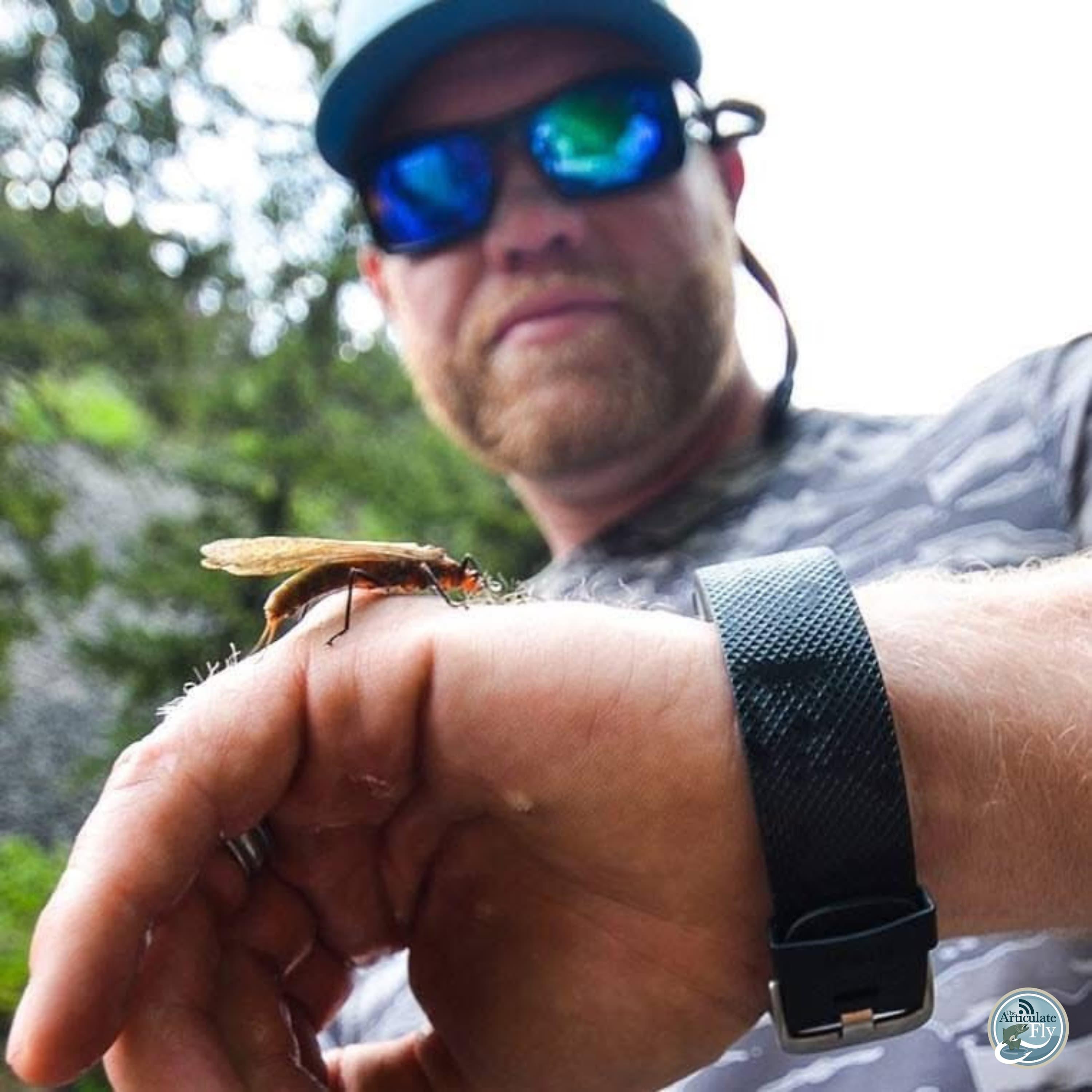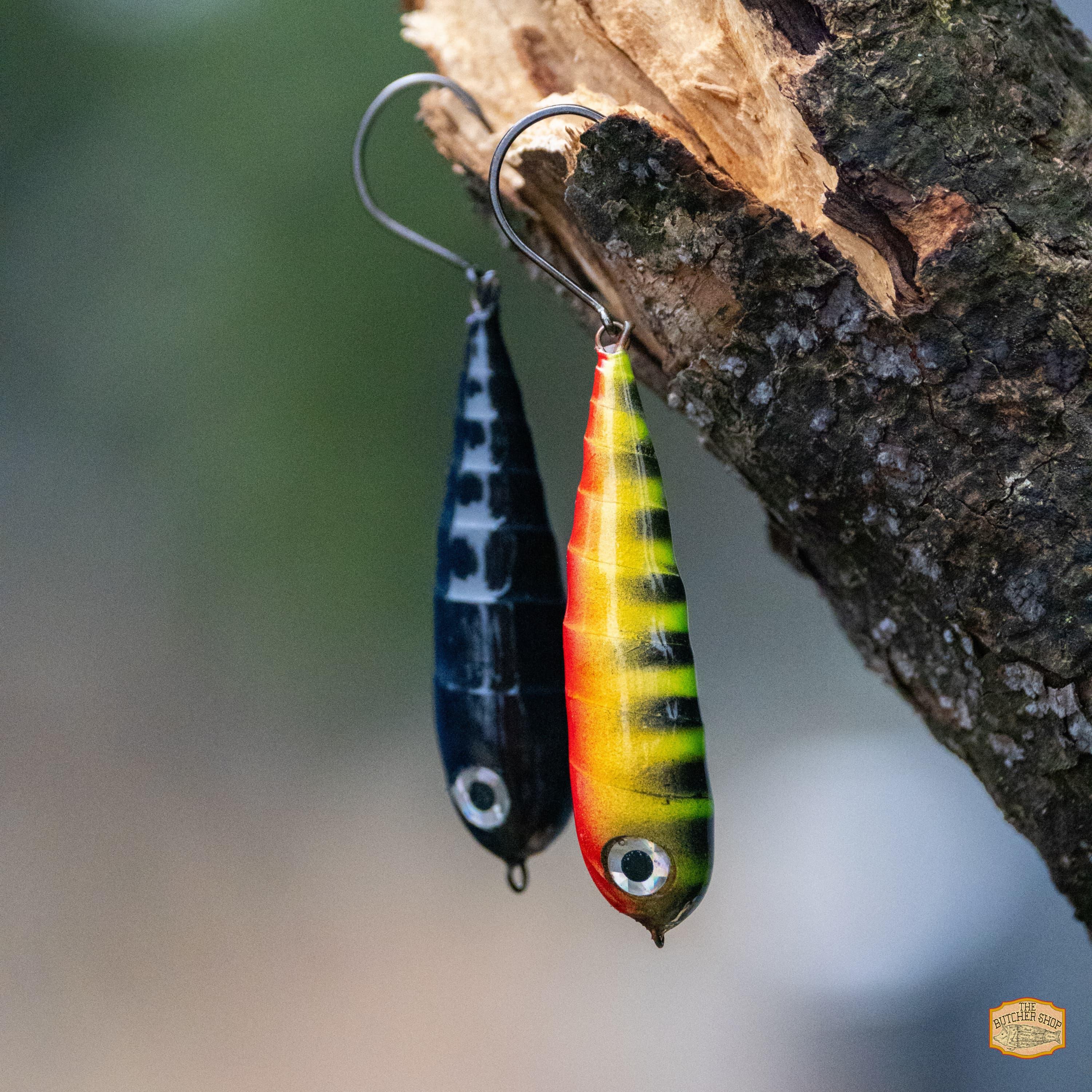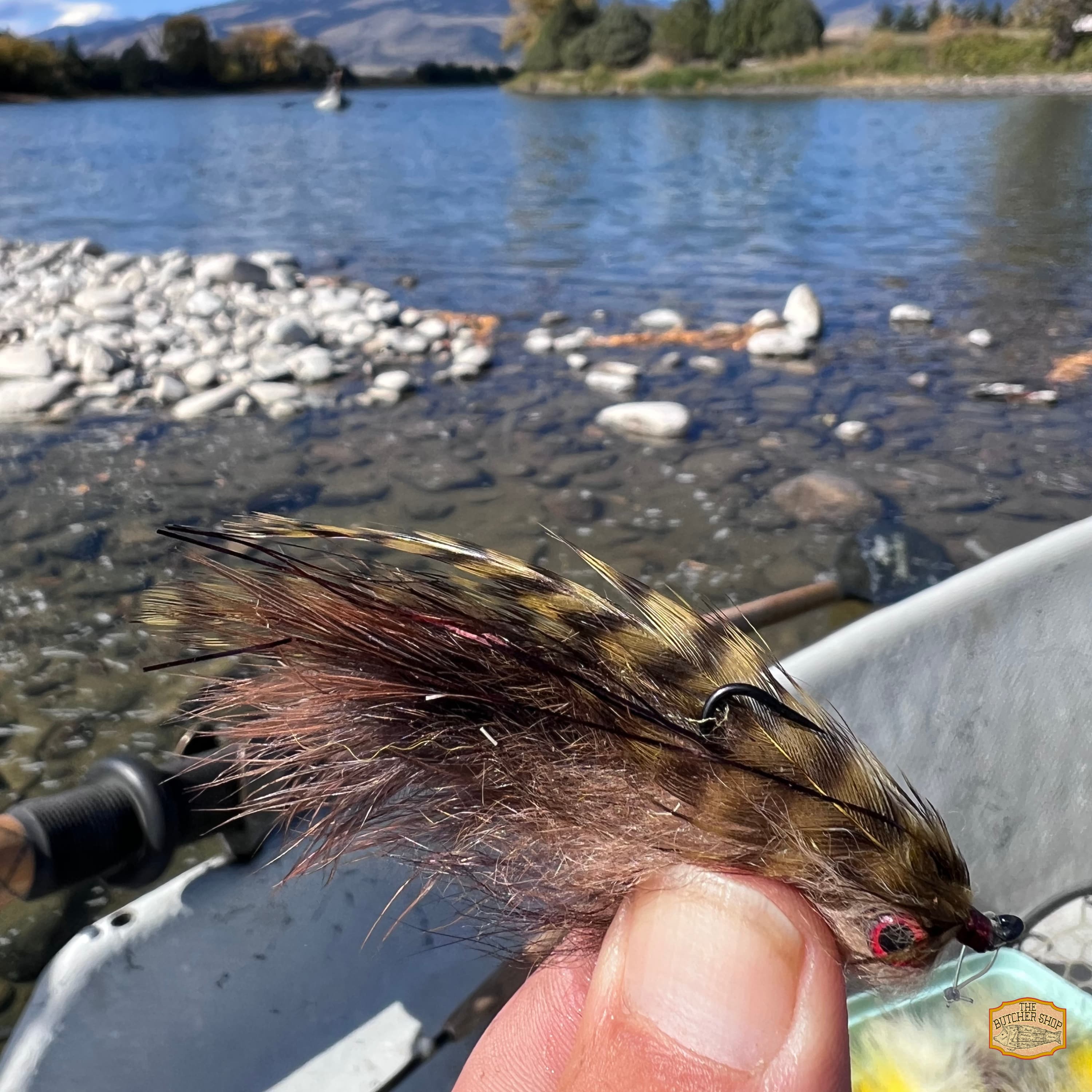S7, Ep 45: Navigating the Waters: Streamers and Strategies in East Tennessee with Ellis Ward
In this episode of The Articulate Fly, host Marvin Cash is joined by Ellis Ward for the latest East Tennessee Fishing Report. Ellis shares his recent experiences on the water, discussing the fluctuating weather patterns and their impact on fishing conditions. With a mix of sunny days and humid, still weather, Ellis highlights the resurgence of insect activity and the excitement of catching a 21-inch brown trout on a dry fly, showcasing the thrill of observing fish rise to the surface.
The conversation shifts to the current state of the Watauga River, where Ellis notes the improved water levels and clarity, leading to more successful outings. He reflects on the challenges anglers faced during low water conditions and the rewarding feeling of landing big fish despite those obstacles. As they delve into the art of streamer fishing, Ellis emphasizes the importance of confidence in fly selection and presentation, sharing tips for those looking to refine their techniques.
Listeners will also hear a listener question about deep-water bass fishing, where Ellis provides insights on using sinking lines and various fly techniques to effectively reach fish at depths of 20 to 30 feet. He discusses the benefits of different fly lines and the significance of leader material in achieving the right sink rate for successful presentations.
This episode is filled with valuable tips and strategies, making it a must-listen for anglers eager to improve their fishing game in East Tennessee.
To learn more about Ellis, check out our interview !
Related Content
S6, Ep 142 - Winter Musky Adventures and Streamer Tactics with Ellis Ward
S7, Ep 50 - The Art of the Follow: Streamer Strategies and Fishing Tales from East Tennessee
S6, Ep 139 - Exploring East Tennessee's Changing Waters with Ellis Ward
All Things Social Media
Follow Ellis and Flyzotics on Instagram.
Follow Ellis on YouTube .
Follow us on Facebook , Instagram , Twitter and YouTube .
Support the Show
Subscribe to the Podcast
Subscribe to the podcast in the podcatcher of your choice.
Advertise on the Podcas t
Is our community a good fit for your brand? Advertise with us.
In the Industry and Need Help Getting Unstuck?
Check out our consulting options !
EPISODE SUMMARY
Guest: Ellis Ward - Guide at Ellis Ward Guides (Johnson City, East Tennessee)
In this episode: East Tennessee guide Ellis Ward shares current fishing conditions and advanced streamer strategies for tailwater and lake fishing. Topics include Watauga River fishing conditions, dry fly fishing on tailwaters, deep-water sinking line techniques and streamer presentation strategies.
Key fishing techniques covered: • Dry fly presentations for rising trout on tailwaters • Streamer fishing with fast-sinking fly lines • Deep water bass fishing with sinking lines and tungsten-weighted flies • Mono rig technique for extreme depth presentations • Leader construction for maximum sink rates
Location focus: East Tennessee tailwaters, Watauga River, lake fishing applications
Target species: Brown trout, smallmouth bass, largemouth bass, striper
Equipment discussed: Rio Outbound Short Intermediate Sink 7, Airflow Streamer Max, Scientific Anglers triple density line, Airflo Shovel Head, Airflo Depth Charge, tungsten cone heads, jig head hooks, marabou flies, fluoro leaders (8-50 pound), Cortland lines
Key questions answered: • How to get flies down 20-30 feet for deep bass fishing? • What sinking line systems work best for extreme depths? • How to construct leaders for fast sink rates? • What's the current state of Watauga River fishing conditions?
Best for: Intermediate to advanced anglers interested in streamer fishing strategies, sinking line techniques, deep-water presentations and East Tennessee tailwater conditions
Marvin Cash
Hey, folks, it's Marvin Cash, the host of the Articulate Fly. We're back with another East Tennessee Fishing report with Ellis Ward. Ellis, how are you?
Ellis Ward
I'm doing pretty good, Marv. How are you?
Marvin Cash
As always, just trying to stay out of trouble. And your weather roll continues. I looked before we started recording.
Ellis Ward
Rolling.Man, it's been high and sunny every once in a while and it's been a lot of days that have chunks of that socked in, insulated, no wind, humid, flat, barometer feeling. And man, the bugs have been out the tail waters, the dams have been releasing. So that was a good stretch there for a little bit.Things got a little dark. But it's okay now, as I promised everyone it would be, including myself. It is okay. But, yeah, now think things are good.You know, I got a 21 inch brown eating a little sulfur. And it was, it was not unlike the situation that, that you and I were in a month or two ago.Kind of up against the edge and just this one was a little more subtle and, you know, just, it was, it was a pretty good cast, but, but more regular. And it's for, for everyone listening, for everyone coming to me. Fishing streamers, there's that.There's been now a number of guys that will make a noise or a face at the dry fly fishing. And like, that's fine. It, it can feel less exciting than the streamer fishing. And I, I totally understand that to a certain extent.I think because of how much I love tying and the absolute confidence with which some of these fish on most occasions will eat a dry fly, that it is both the right fly and presented the right way. Like, you know, you're seeing the mouth come up. You're. You're watching it, you're.You're getting that there's, there's a bunch of semi nerdy casting stuff involved there, but that game is just so fun and it's, it's such a part of my fishing and my guiding that for. Honestly, a lot of it was clean. There was just so much sediment in the water that these bugs weren't coming up in the winter.And I mean, in the winter I've had, you know, blanket blue wing days that we just didn't get this last year. And, and so, you know, you ended up opening a little bit of a, a can of mental worms here. Marv.Actually, just a weather question, but the Wataga has been, you know, we, we've been talking about this now every, every podcast since October. This was the first, like, it's it's running. It was running 3,000 and then stepping down to 2,000 for 24 hours a day. And like, it's pretty clear.And in that big water is when I, I got that big fish and there's, you know, there's a lot of bugs coming off. And so it's just. It was so low for so long. It was getting hot, um, somewhat unseasonally warm.And, you know, there were carp in the lower river and it just. Stuff wasn't really feeling right. And, and that was after a long winter. So it's.Everything feels like it's, it's right sized a bit in the last week or two.So I'm pumped and, you know, to, to everyone, including yourself who, who came out and, and slogged it out and man, we put some big fish in the boat and got some nice eats. But we had some tough days fishing that low water. We made it happen. And, and it's just different opportunities now.And, and I haven't even talked about mousing, so it's. Excited.
Marvin Cash
Yeah, no, it looks pretty good. And I just got another batch of dates for you, so I'll be back soon. And got a question for you from Chris.And he's competing with a buddy in a boat fishing a bait caster, and he's trying to fish deep for bass. Looks like he's probably finding them on electronics.He says they're 20 to 30ft down, but he's having a hard time consistently getting his streamer down there and presenting it and catching fish. Any suggestions?
Ellis Ward
Yeah, size 8 gamma race hook with two or three night crawlers affixed to it, I think, and, and some lead. While that would absolutely pound some fish hanging out, that is a joke. So if you're, if you're trying to get down to 20 or 30ft, I'm.I've never done this in the lake.Most of my lake fishing is, you know, I'm looking for, for bass popping on top and, you know, fishing near the ends of the tail waters for, for striper in, in zones without electronics. But I've done plenty of saltwater fishing, and in, in that context, it's, it's almost identical.And this is something that I learned from striper fish in the, in the Chesapeake. But it's, it's all over. Right. And so the same goes for lakes you want to get down to your electronics. You're.You're looking at 30, you know, 20, 30ft. There's a lot of different lines out there that have sync rates. If you're Fishing a fly that is buoyant, it's just gonna take longer.But you should be able to count it down. And what that means is let's say you have a 7 inch per second sink rate. That's just a line.So you need to count, turn that into feet and get, and get the, the number of seconds down in your head roughly. And then, you know, add 10 seconds, take five away.And if those fish are going and you're getting down into bait, then it's just a matter of finding where that presentation is relative to the depth that you're looking at and how long it takes to get down there. Something else to consider. And, and I would say that this is especially for a, you know, let's say it takes 20 seconds, 25 seconds to get down there.That's if, if you're, if you're seeing fish that aren't really hanging that long or the bait ball's moving or you have to be moving, something else to consider would be these start to become additive. So you have a really fast sinking line terminating in 7 inches per second. There's a number of different fly lines that do that.The Rio Outbound Short Intermediate Syn Sync 7, the airflow streamer Max long and short, I believe terminate in seven scientific anglers makes a triple density line. There's, you know, their, their sonar line and airflow also makes the, the shovel head.I think Kelly Gallup has done some Cortland stuff that I'm sure terminates in a very aggressively quickly sinking end. And then there's, there's a few that are just, they're somewhat nightmares to cast.And you know, one of them being the, the airflow big game depth charge, I think it might be, and it's like the whole thing is, is 7 or 9 inches per second. But on top of that, if you, if you add on, I'm going to try to make this quick so I might end up talking quickly here.If you add on, this is going to be the, the wrong thing to do. But it's a good example. If you add on 50 pound fluoro straight to your fly line and you only add a foot of it on, right?And you have something floaty or neutrally buoyant attached to it. It's just going to be floating down at the same rate as the line or maybe even slowing it down. And what we want to do is the opposite of that.So if you can increase the distance from your sinking fly line to something with, you know, relatively light tippet, 12 pound, 10 pound, 8 pound, fluoro and you extend that distance so that it's getting away from what we want to be a slower sinking thing that's our fly line than our fly which if you're tying with let's say a tungsten cone head and just a couple palmers of, of marabou or you know, a 316 ounce jig head with a couple chunks of marabou put on it, maybe some flash something, you know, tungsten eyes with like a little sparsely tied Creole ex with tungsten eyes. They make tungsten everything now.But you know, with some open loop casts and 7, 8, 10 foot leader that is, you know, relatively masts free as opposed to you know, the high mass 50 pound fluoro. So what we want to avoid is that fly and the line trying to sink a lot of leader.So if you have a super sinky fly with a big distance of not a lot of mass liter, that thing's going to be sinking really, really quickly. And so combining all of this to get that like I want to get down as fast as possible as quickly as possible.Something sparsely tied with a material that absorbs water and, and moves freely. So you know, crex chronic flash marabou craft fur and you know, tungsten head or a jig head hook attached to um.Yeah, catch that 7 to, to 12 foot leader, you'll, you'll be getting down very quickly. And if you can't get down far enough with that setup then you have officially encountered. You already have.The reason why fly fishing is, is as limited in in scope as it can be and we always want to try to find ways around it. But it's fly line is really it.You can also, you know, depart from a lot of this conversation and just do the mono rig and, and run a, you know, a little jig head marabou something or other. And like you're going to be down there very quickly. And so I'm going to save some time because we're going to be at, at the limit here in a moment.But if you look up the mono rig, it's just replacing a lot of that. It's, it's putting on you know, 50, 60, 70ft of mono in front of your fly line.And Euro guys, you know, streamer fishing with that, trying to get it down. There's, there's a lot of different applications that, that came out.And of course the question of whether or not it's fly fishing doesn't sound like anyone here cares. You want to pound some fish and get down to 20 or 30ft so that could be the answer too.
Marvin Cash
Yeah. And I would say too, the great thing about those lines is they, they hinge less than the older lines used to.So, you know, you go through all this pain and suffering to get the fly down. You kind of want it to stay in the zone as much as possible.
Ellis Ward
Yeah. And that's where you know, the, the depth charge and, and some of these other scientific anglers sort of sticks out the, the triple density line.And I do a lot of river fishing and I've experimented with and used every line I can get my hands on because I always want to find the best answer that we have when we have it.And so for, for my application, some of those actually became, I cannot have clients fishing them just because it's, it's too much of a liability and I'm basically giving someone something that's going to break a rod.And, and when I say that I'm, I'm talking about the, the propensity for like the, the airflow depth charge and the scientific anglers triple density too with a 30 foot cast.The running line and you know the, the back end towards the running line of the, the belly of that fly line is sinking so fast that you know that whole thing, the whole system is sinking as opposed to just the, the end of it near your bug that it'll wrap on rocks and do a bunch of other tough stuff. But those can be fantastic applications for, for the lake fishing where that, that whole, the whole thing is sinking.And then you have an intermediate or a 1 inch per second running line that Marv, like you said, you're, you know, if you're thinking of it like a diagram, it's, it's going to be a straight, a straight line angled down from the boat as opposed to a. Now something that looks like a parabolic curve.
Marvin Cash
Yeah, absolutely. You know folks, we love questions on the articulate fly. You can email me or DM me on social media, whatever is easiest for you.And if we use your question, I will send you some articulate fly swag, maybe even a butcher shop sticker. We are drawing for some cool stuff from Ellis at the end of the season.And Ellis, before I let you hop, you want to let folks know how to get in touch to get on the boat. Talk about fishing bucktails and all that kind of good stuff.
Ellis Ward
Yeah, best way to talk about all that stuff is my cell phone at 513-543-0019 on Instagram at Ellis Ward guides and bucktails and flies musky lures information on trips. All that stuff is @Ellis Ward flies dot com.
Marvin Cash
Well, there you go. Well, folks, as I always say, this time of year, yo, it's yourself to get out there and catch a few tight lines, everybody. Tight lines, Ellis.
Ellis Ward
Appreciate it, Marvin.

Ellis Ward
Guide | Fly Tier
I am a full time, year round fishing guide in East Tennessee, based out of Johnson City. I also design and tie flies from midges to musky, process a thousand or so bucktails every season, teach at East Tennessee State University, and raise my daughter.











